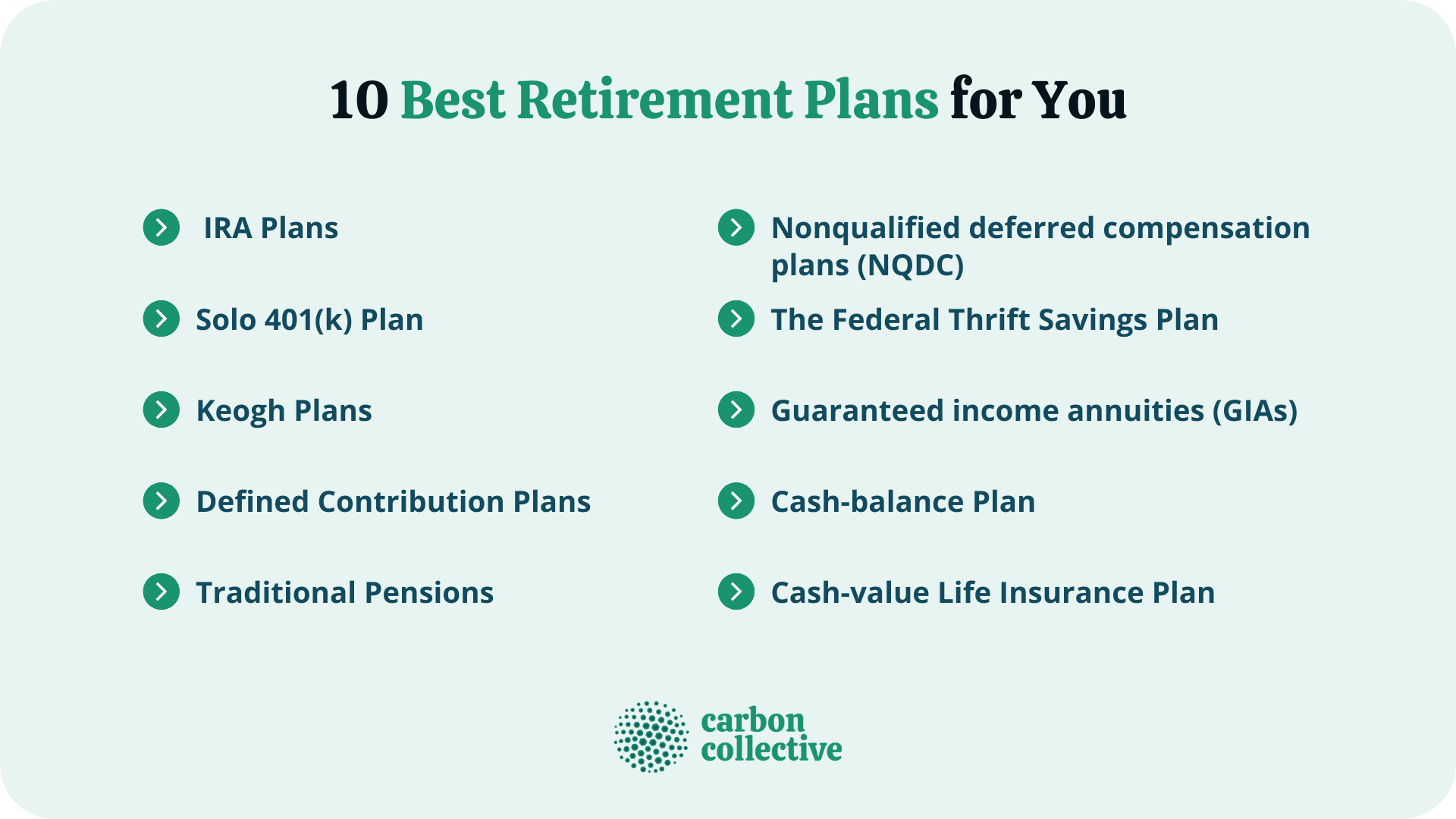Top Retirement Plans: The Best Options to Secure Your Future
Planning for retirement is essential, yet it often gets postponed because many people are unsure of where to start. Understanding the best retirement plans available can help ensure financial security during your later years. In this article, we’ll dive into the top retirement plans, their benefits, and how to choose the right one for your needs.

Why Retirement Planning is Important
Retirement planning involves saving and investing money to secure your financial future when you no longer work. Without proper planning, you might find yourself struggling with finances during retirement. Having a solid retirement plan can provide peace of mind, knowing that you’ll have enough funds to live comfortably when you retire.
Key Benefits of Retirement Planning
-
Financial Independence: A well-thought-out retirement plan allows you to live comfortably without relying on others.
-
Tax Benefits: Many retirement plans come with tax advantages, enabling you to save more.
-
Long-Term Security: By investing early and wisely, you can secure your financial future and protect yourself from unexpected expenses.
Types of Retirement Plans
Several retirement plans cater to different needs, ranging from employer-sponsored options to individual retirement accounts. Here’s a breakdown of the most common types:
1. 401(k) Plan
A 401(k) is one of the most popular employer-sponsored retirement plans. It allows employees to contribute a portion of their salary to a tax-advantaged account. Often, employers match contributions, which can significantly boost your savings.
Benefits of a 401(k):
-
Employer Match: Many employers offer to match a portion of your contributions, essentially giving you “free money.”
-
Tax Advantages: Contributions to a traditional 401(k) are tax-deferred, meaning you won’t pay taxes on the money until you withdraw it in retirement.
-
High Contribution Limits: In 2023, you can contribute up to $22,500 annually, with additional catch-up contributions for those 50 and older.
2. IRA (Individual Retirement Account)
An IRA is another excellent retirement savings option. There are two types: Traditional IRA and Roth IRA. Both offer tax benefits but differ in how and when they are taxed.
-
Traditional IRA: Contributions are tax-deductible, but you’ll pay taxes when you withdraw the funds in retirement.
-
Roth IRA: Contributions are made with after-tax dollars, but your withdrawals are tax-free, provided you meet certain requirements.
Benefits of an IRA:
-
Tax Flexibility: Choose between the tax-deferred growth of a Traditional IRA or the tax-free withdrawals of a Roth IRA.
-
Wide Investment Options: You have more control over your investment choices compared to employer-sponsored plans.

3. Pension Plans
Pension plans, or defined benefit plans, are employer-sponsored retirement plans that guarantee a specific monthly payment upon retirement. Although these plans have become less common, they provide reliable income for retirees.
Benefits of Pension Plans:
-
Guaranteed Income: You’ll receive a fixed, predictable monthly payment for the rest of your life.
-
No Investment Risk: Unlike 401(k)s, you don’t need to worry about market fluctuations affecting your income.
4. SEP IRA (Simplified Employee Pension)
The SEP IRA is a retirement plan designed for self-employed individuals and small business owners. It allows contributions to be made by the employer on behalf of employees, and it provides higher contribution limits compared to a Traditional IRA.
Benefits of SEP IRA:
-
Higher Contribution Limits: Employers can contribute up to 25% of each employee’s salary, up to $66,000 in 2023.
-
Simplicity: The plan is easy to set up and administer, making it ideal for small businesses and self-employed individuals.
5. Solo 401(k)
The Solo 401(k) is tailored for self-employed individuals and small business owners with no employees other than a spouse. It combines the benefits of a 401(k) with higher contribution limits and the flexibility of a traditional retirement account.
Benefits of Solo 401(k):
-
High Contribution Limits: In 2023, you can contribute up to $66,000 or $73,500 if you’re 50 or older.
-
Loan Option: You can borrow from your Solo 401(k), which can provide access to funds in an emergency.
6. Health Savings Accounts (HSAs)
While not strictly a retirement plan, a Health Savings Account (HSA) can be a powerful tool for retirement planning, especially for healthcare expenses. HSAs allow you to save tax-free for medical costs, and unused funds can be rolled over year after year.
Benefits of HSA:
-
Triple Tax Advantage: Contributions are tax-deductible, the account grows tax-free, and withdrawals for medical expenses are tax-free.
-
Retirement Savings: After age 65, you can withdraw funds for non-medical expenses without penalty (though you’ll pay income tax).
How to Choose the Best Retirement Plan
When selecting a retirement plan, it’s essential to consider your financial goals, employment status, and tax situation. Here are some key factors to help you make the best choice:
1. Consider Your Employment Status
-
If you work for an employer, a 401(k) or 403(b) might be the best option, especially if they offer a match.
-
If you’re self-employed, SEP IRAs, Solo 401(k), or Traditional IRAs may offer more flexibility and higher contribution limits.
2. Understand Tax Implications
-
If you prefer to lower your taxable income now, a Traditional IRA or 401(k) may be more suitable.
-
If you prefer tax-free withdrawals in retirement, consider a Roth IRA.
3. Evaluate Your Savings Goals
-
If your goal is to accumulate substantial savings for retirement, opting for a 401(k) with employer matching contributions can provide a strong foundation.
-
For those focused on healthcare expenses in retirement, an HSA may be a useful addition to your plan.
Retirement Plan Comparison
Here’s a quick summary of the top retirement plans to help you decide which one fits your needs:
| Plan Type | Contribution Limit | Tax Advantage | Best For |
|---|---|---|---|
| 401(k) | $22,500 ($30,000 if 50+) | Tax-deferred growth | Employees with employer match |
| IRA | $6,500 ($7,500 if 50+) | Tax-deferred (Traditional) or tax-free (Roth) | Individuals seeking tax advantages |
| Pension Plan | Varies | Guaranteed monthly income | Employees with a defined benefit plan |
| SEP IRA | $66,000 | Tax-deferred | Self-employed individuals or small business owners |
| Solo 401(k) | $66,000 ($73,500 if 50+) | Tax-deferred | Self-employed individuals with no employees |
| HSA | $3,850 (self), $7,750 (family) | Tax-free for medical expenses | Those planning for healthcare costs in retirement |

Frequently Asked Questions (FAQs)
1. What is the best retirement plan for someone self-employed?
For self-employed individuals, the Solo 401(k) and SEP IRA are the best options. Both provide higher contribution limits compared to a standard IRA and offer flexibility for your retirement savings.
2. Can I have multiple retirement plans?
Yes, you can have multiple retirement accounts. For example, you could contribute to both a 401(k) through your employer and a Roth IRA or Traditional IRA.
3. What happens if I withdraw from my retirement account early?
If you withdraw funds from most retirement accounts before age 59½, you’ll likely incur a penalty of 10% in addition to any taxes owed, unless you meet specific exceptions.
4. Can I change my retirement plan after I start contributing?
Yes, you can switch between retirement plans, but it’s important to understand any tax implications or penalties that may apply. Consult a financial advisor to ensure you’re making the best choice.
Conclusion
Choosing the right retirement plan is a crucial step in securing your financial future. By understanding the various options available and considering your personal financial goals, you can make an informed decision. Whether you’re looking for tax benefits, employer matching, or self-directed investment opportunities, the right retirement plan will help you build the foundation for a comfortable and financially secure retirement.
:max_bytes(150000):strip_icc()/TheBestRetirementPlans3-c1bd4670fc674fe09df439aa0acd243d.png)



